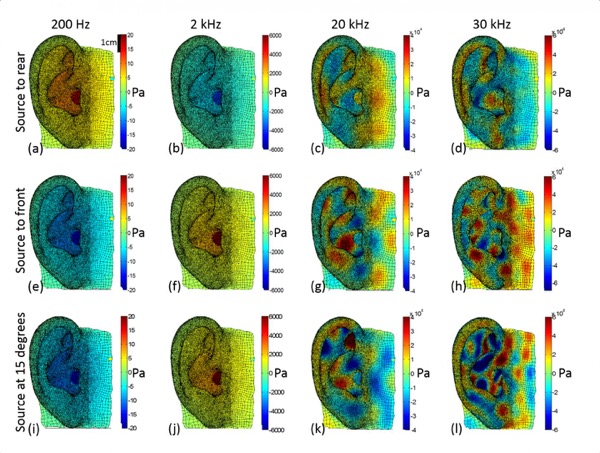While ultrasonic death rays are still a thing of fiction, there is growing evidence that exposure to ultrasonic waves may cause adverse health effects.
ACOUSTICAL SOCIETY OF AMERICA - WASHINGTON, D.C., May 9, 2018 -- New technologies for mobile devices may use ultrasonic sound waves for a variety of purposes, from charging your phone when you enter your room to collecting data on which advertisements you watch. Pest deterrents, dog controllers, some automatic sliding doors, public address voice alarms -- and even a device marketed in the U.K. as a teenager repellant to keep kids from loitering outside storefronts -- also emit ultrasound at different frequencies.

The real part of the scattered pressure (in Pascals) from a point source placed 1 m from the opening of the ear canal, and in the same horizontal plane, showing variations when the source is (a-d) directly behind the ear, (e-h) directly in front of the ear, and (i-l) angled 15 degrees outward. The columns from left to right show increasing source frequency. Image credit: Leighton.
These devices have varying effects on different subsets of the population, and many of these are covert, or inaudible, so the public usually doesn't know when they are exposed.
Regulation of these emerging technologies is in many ways "the wild west," according to Timothy Leighton at the University of Southampton, who wrote a guide for moving forward in today's new world of ultrasonic exposure. His work outlines a logical approach for advancing research on ultrasonics.
"I looked at all this stuff, and I said, 'This is an amazing detective story,'" Leighton said. "I began to pull together a picture that, in fact, the public was being exposed."
Leighton is an expert in ultrasonics and underwater acoustics, who analyzed the landscape of ultrasonic regulations. He discovered a string of regulations that were all based on insufficient data, but had been shared around the globe.
"It was extraordinary when you opened up this topic," Leighton said. He found that many national safety guideline limits could be traced back to a handful of studies performed in the 1970s on "a small number of adult men, many of whom had experienced gunfire, some of whom had worked in the rock-n-roll hi-fi industry... So it was inadequate data on which to base standards."
Emerging technologies are often marketed as harmless in terms of emitted ultrasound. Ultimately, Leighton found that these claims are not based on any scientific evidence.
He found a series of anecdotal complaints, ranging from nausea and dizziness to irritability and ringing ears, that were attributed to ultrasound exposure. However, there is little data in this field, partly because studies to test exposure on humans could be unethical. So, obtaining data from human subjects will require innovative approaches to research.
Leighton described his work uncovering the strange history and uncertain future of the use of ultrasonic sound waves during the 175th Meeting of the Acoustical Society of America, held May 7-11, 2018, in Minneapolis, Minnesota. He will also discuss why the 2017 incident in Cuba -- when U.S. embassy workers experienced strange symptoms of hearing loss and confusion -- was unlikely to have been caused by ultrasound.
"I think 70 years is too long to go with inappropriate guidelines," Leighton said. "If it's public exposure, you're going to have children and newborns exposed as well, and we have no information whatsoever on how safe it is for them."
###
Presentation 3pPA1 "Ultrasound, human health, safe levels, and Cuba: What do we know?" by Timothy Leighton, The 175th Meeting of the Acoustical Society of America, May, 2018, Minneapolis, Minnesota.
ABOUT THE ACOUSTICAL SOCIETY OF AMERICA
The Acoustical Society of America (ASA) is the premier international scientific society in acoustics devoted to the science and technology of sound. Its 7,000 members worldwide represent a broad spectrum of the study of acoustics. ASA publications include The Journal of the Acoustical Society of America (the world's leading journal on acoustics), Acoustics Today magazine, books, and standards on acoustics. The society also holds two major scientific meetings each year. For more information about ASA, visit our website at https://www.
Source: https://www.eurekalert.org/pub_releases/2018-05/asoa-uai042618.php

